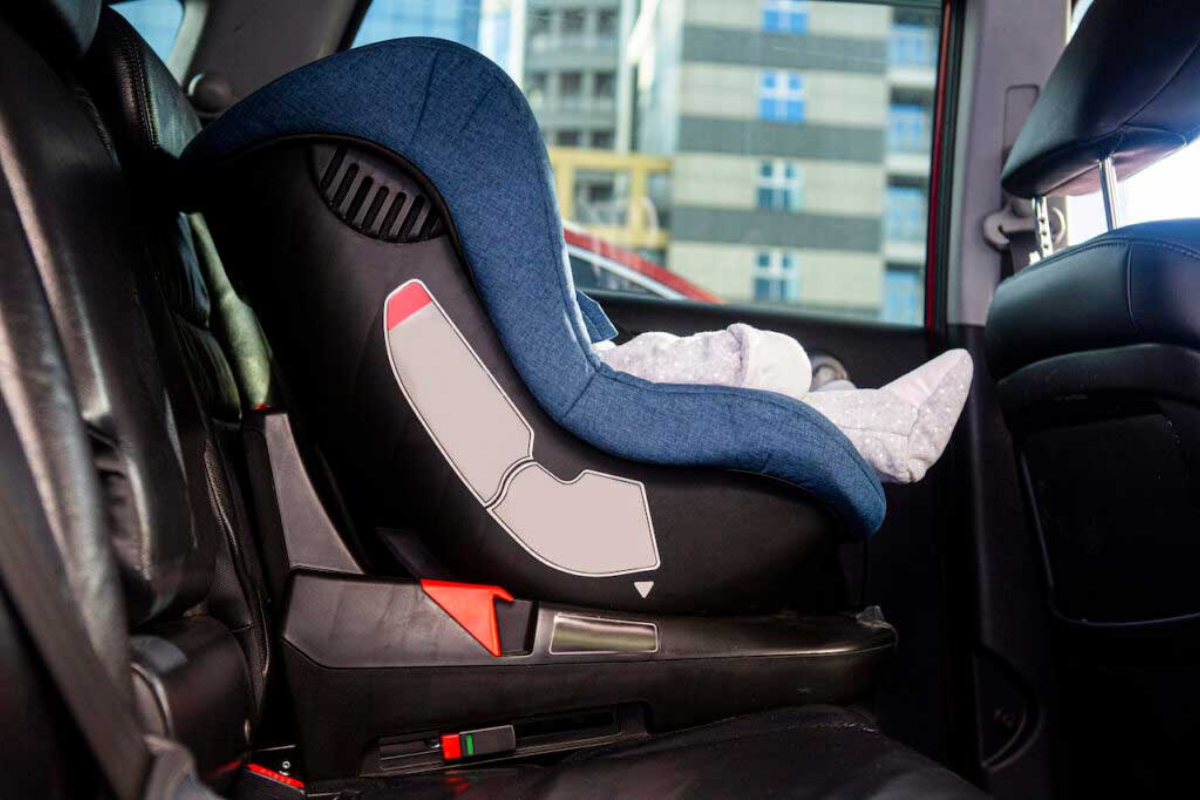I am not so old that I do not remember car seats as a child. However, I definitely do not recall them as a permanent fixture in the car. There were many, many car trips with three kids and my grandmother in the back seat, the smallest child held (buckled!) in her lap. I doubt my family ever used a booster seat in the car, and by 8 or 9, I was permitted in the front seat. To be clear, my family was on the risk-averse end — seat belts at all times, defensive driving, and so on.
Car seat rules have evolved over time. In the present moment, children under age 2 are in infant seats, usually facing backward. Age 2 to 4 brings the giant five-point-harness car seat (when we finally disposed of the last of these, I can only describe my husband as gleeful). And in many places, kids up to age 8 are still required to be in booster seats. Recommendations often suggest continued booster use up until the age of 12.
These regulations have accelerated since the 1980s and especially since the mid-1990s. In a somewhat surprising fact, a 2020 paper argued that the regulations have impacted fertility. The idea is that people do not want to have a third child because they cannot fit in another car seat. Seriously, that’s what the paper says. Almost a 1 percentage point drop in third births! Once you hit kid number three, you’ve got to go to a minivan. Maybe it’s not worth it?
For the most part, car seat behavior is dictated by these regulations. But many people wonder why these are in place — what is the evidence? Beyond this, we may wonder whether it makes sense to go beyond the recommendations — if the recommendation is that a child be rear-facing until they are 2, should you go further?
Here, I’ll take you through the main car seat transitions.

Car seat transition #1: Infant to toddler seat
This first transition depends on the type of car seat you purchased when your child was an infant. If you purchased a smaller infant seat, your child will certainly grow out of it while they still need to be rear-facing. At this stage, you’ll then buy a convertible car seat that can face both rear and forward. There are also larger infant seats, which might be large enough to keep your child in until they are ready for a forward-facing seat (which may last indefinitely).
The advantage of choosing a smaller infant seat is that it’s lighter and can often be attached to a stroller. The disadvantage is you may have to make one additional seat transition.
There are some car seats that make all the transitions — infant to convertible to forward facing and beyond. They tend to be on the more expensive side.
Car seat transition #2: Rear-facing to front-facing
Infants sit in an infant seat, and they face backward. This is understood and accepted, and, indeed, they will not let you leave the hospital until you show that your child is in the car seat correctly. It has always been recommended that children continue to face backward until the age of 1.
Recently, this age has been moved to 2, and many people feel it should go further. We may reasonably ask, why 2 years? If rear-facing is safer, why should there be an age cutoff at all?
The idea is driven by the biomechanics of what would happen if you were in a car accident. Tests with crash test dummies sized between 1 and 3 years (i.e., this paper) suggest less risk of injury (to the dummies) with rear-facing than forward-facing car seats. These tests are very convincing since they are run in controlled environments, with dolls equipped with fancy accelerometers.
Translating this to data in the real world has been more of a challenge. In 2007, a very influential paper was published comparing injury rates in crashes between children using forward-versus rear-facing car seats. Using data from the National Highway Traffic Safety Administration, the authors argue that children ages 12 to 23 months are five times as likely to be injured in a side crash if in a forward-facing seat and twice as likely overall. This paper played a large role in the push to stay rear-facing for longer.
However, this paper turned out to be based on an unreliable method.
In 2017, the journal was contacted by an outside researcher who had been unable to replicate the analysis. The original paper writers then revisited their analysis and found that they were also unable to replicate it. The issue, according to the journal, was thought to be a mishandling of survey weights, which caused their sample size to seem bigger than it was.
The authors retracted the original paper and redid the analysis, now with more years of data, publishing an update. Their conclusion was that while the direction of the effect was still in favor of rear-facing seats, it was not significant, and the effects were small (0.5% of children 12 to 23 months in forward-facing seats were injured versus 0.2% of those in rear-facing. But the actual number of injuries was only 14 and 3, much too low to get any significance).
This result is consistent with the findings of a 2023 study, which found some small and marginally significant reductions in injury risk with rear-facing seats. That study found that the reductions in injury risk only appeared for children who were not seated in the middle seat and were only significant for children under 2.
This is all consistent with a world in which the biology/mechanics/theory shows that rear-facing has advantages, but the real-world data suggests these may be quite small. And there are some trade-offs: as children get larger, facing backward becomes more cramped and uncomfortable. Kids who get carsick facing backward may feel better facing forward. There is a balance here. If your child is happy facing backward, it’s great to leave them. If they are puking and screaming on every car ride, it may make sense to turn them sooner.
Car seat transition #3: Toddler seat to booster seat
A forward-facing car seat generally combines a booster component with a five-point harness that holds the child in. At some point, most people move away from using the harness. This could involve switching to a smaller seat, which is simply a booster, or modifying the existing high-back car seat to remove the harness component and use a regular seat belt instead.
There is little data to dictate when that change should take place, and from a safety standpoint, any differences are likely to be so small that detecting them in data would require a much larger sample size than is feasible. The primary consideration for when to move is developmental.
A harness keeps your kid seated upright in a protected position. A seat belt does not. If used correctly, they should be similarly effective. But if your child is crawling out of the seat belt or messing around, then the risks of an accident go up. The time to move is when they are old enough to mostly sit upright on their own.
Car seat transition #4: Out of the booster seat
Does your child need to be in a booster until they are 8, 10, or 12? My older kid is quite tall, and by the time she moved into a real seat, she was as tall as some short adults. Was there any real point in maintaining the booster for so long?
The arguments behind a booster seat are also based on biomechanics. Children are short. Seat belts are built for taller people. This means they are less suited to protecting little kids in an accident than protecting adults. Booster seats (or “belt-positioning boosters,” as they are sometimes called) are designed to get kids tall enough to optimize seat belt functioning.
A number of years ago, Steve Levitt (of Freakonomics fame but also a friend of mine) wrote several papers arguing that, in fact, booster seats didn’t protect children from serious injury or death. This conclusion was subject to a lot of criticism and scrutiny. Notable to me, though, from a parenting standpoint, is that the papers do find that boosters reduce less serious injuries. I would leave my kid in a booster just for that.
But even if you aren’t as concerned about less serious injuries, follow-up work suggests larger safety improvements, including for older kids. One set of example papers are this one and this one, which uses data from State Farm Insurance on younger and older children to examine the effect of booster seats on injuries. The authors argue that the use of booster seats reduces injuries, even for kids 4 to 7. An obvious complaint with both papers, though, is that they use parent-reported injuries and parent-reported seat use. Variations in honesty or memory could bias results.
Better, I think, is this paper, which relates variations in state booster laws to estimate the relationship between boosters and accident fatality rates. The authors find that fatality rates among 6- and 7-year-olds dropped in places that introduced booster laws for those age groups relative to those that did not. They find similar results for 4- and 5-year-olds, but there is less variation in those groups, so the results are weaker. I have some quibbles with the paper (I do not like their figure presentation), but this is a good approach to the problem and an important finding.
There isn’t any real data I can find on booster seats for kids beyond the age of 8, partly because they aren’t legally required, which makes it hard to have any true variation (more careful drivers are likely to keep children in boosters for longer, for example). But what is important to note is that it’s not so much about age as size. A very tall kid may be ready to be out of a booster before a short one.
The upshot is that even though boosters are annoying, my read is that even in the absence of regulations, it is a good idea to keep children in them until they are fairly old.
The bottom line
- Which car seat you start with influences how many transitions you’ll make: smaller infant seats require an earlier switch to a convertible (or toddler) seat, while larger or all-in-one options reduce transitions but are bulkier and pricier — it’s a trade-off between flexibility, cost, and convenience.
- While crash-test data suggest rear-facing car seats are safer, especially under age 2, real-world evidence is less definitive. There are trade-offs to consider in this decision related to your individual child (such as carsickness.)
- There’s little data on the ideal time to switch from a five-point harness to a seat belt in a booster, but the key factor is whether the child can sit upright on their own.
- Research supports that booster seats lower the risk of both minor and serious injuries, making it reasonable to keep kids in boosters until they are fairly old.





















Log in
Your Bottom Line says “For any car seat transition, it’s not really about age but size. Especially on the issue of boosters, the concerns arise because children are shorter than adults. This means that some of the choices about boosters should reflect the size of your kid.”
I have a 4yr old daughter in the 90th percentile of height so she has outgrown her age group and many older children. We switched her to a booster seat the moment she turned 4, thinking it was just the size rule. However, we’ve since learned that a child’s pelvic bone is actually still “soft” at this age and not capable of withstanding the impact from just a simple seatbelt restraint until the age of 10 when it fully hardens into bone from it’s original cartilage state at birth. They need TIME for their bones to harden, which implies age not just size. Seatbelts, even in a booster seat setup, is not as safe for her bone structure as a 5-point harness until this age.
I am surprised that in the US the recommendation to keep children rear-facing is only until age 2. Where I live, it is until at least age 4. Thus, I would like to hear your thoughts on the Plus test. We chose our (rear-facing) seat based on passing the PlusTest (and being rear-facing until age 7 + easy to install + ok size). I’ve understood that rear-facing seats have a clear advantage in the types of crashes covered by the Plus test. Of course children are different and for some it might be difficult to stay rear-facing but I was under the impression that rear-fecing seats are always safer for the neck, no matter what the age. Is this not the case?
https://www.vti.se/en/services/crash-safety-testing/child-restraint-systems/the-plus-test
A note here: booster seat laws vary by state, and a few states DO require them after age 8. Where I live in Maine, kids are required to be in booster seats until they are a certain age, AND ALSO 4 foot 9, AND ALSO 80 pounds. This means some kids are legally required to be in a booster seat until partway through middle school! There are a few other states like this. Are there actual data to support this? We checked our kids with the lap belt without a booster (with the car parked) and the lap belt appears to fit them just fine, not over their necks or anything. So why do we have to wait until our skinny minis get to 80 pounds?? Imagine the humiliation of rolling up to middle school in a booster seat.
Hi Amanda, I am also from Maine! I recently looked at the state law and your comment had me worried that I read it wrong, because mine is tiny too. I just double checked and good news, the rule only applies to kids who meet ALL three conditions, not ANY. Our kids don’t have to stay in booster seats till middle school!
“The operator shall ensure that a child who weighs less than 80 pounds, who is less than 57 inches in height and who is less than 8 years of age is properly secured in a belt positioning seat or other child restraint system”
Back seat only till 12 though:
“The operator shall ensure that a child who is less than 12 years of age is properly secured in the rear seat of a vehicle, if possible. “
NHTSA is currently investigating the popular Nuna Rava car seat for a (seemingly common) harness malfunction. How should we think about using these seats while the investigation is ongoing? There are no formal recommendations yet, but the data that has been published so far on the NHTSA website as part of the investigation is concerning.
Can you post the link? I haven’t heard of this issue. We have been using the Nuna rava (installed with the car’s seatbelt and the back teether) for almost 4 years without any issues. Love it actually.
https://www.nhtsa.gov/?nhtsaId=PE24026
Thank you for this! It’s hard to get good car seat info without encountering fear mongering. It really is a challenge to fit 3+ car seats into a car & being able to move a kid to a booster (or out of one) honestly makes life so much easier. Would love to know what you think about the (many) car seat FB communities that seem to have SO many complicated installation rules. It’s more than just making sure the seat is tightly installed and your child is securely buckled in. Any time I have EVER seen someone post their car seat install, the CPSTs find something wrong with it 🙁 They also say that safety has less to do with size and more with age because of the maturity of their bones. All of the rules and regulations really make you want to throw your hands up because it seems like it’s impossible to get it right!
@krisk,
Totally. When we had our 2nd child we went to a carseat safety check at a children’s hospital in a major city. The tech pulled out the manual for our specific car and it said carseats should NOT be in the middle seat for that car. So we put the 2 seats on either side in the back. Then when I posted about this, a bunch of people were demanding the name of the tech, insisting she was wrong and dangerous. I don’t know, she seemed right about the manual, and why trust people on the internet over a tech at a legit event? But they were insistent they were right for various reasons and she was wrong. Stressful!